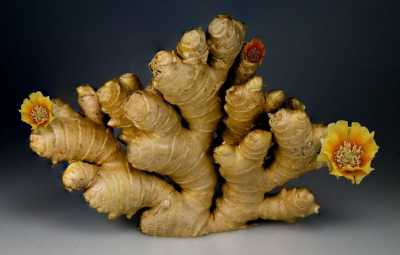 Photo by Joris Neyt
Photo by Joris Neyt
Top 10 frequently asked questions about Ginger
Ginger, a flavorful and aromatic root, has gained significant attention in the realm of natural remedies and culinary applications. Known for its distinctive taste and potential health benefits, ginger has been used for centuries in traditional medicine and culinary traditions across various cultures.
This versatile root is celebrated for its potential anti-inflammatory, digestive, and antioxidant properties. Whether consumed fresh, dried, as a spice, or in the form of teas and supplements, ginger offers a unique combination of flavors and potential health-promoting properties that continue to intrigue and captivate both chefs and health enthusiasts alike.
-
Can ginger reduce belly fat?
There is limited scientific evidence to support the claim that ginger specifically targets belly fat reduction. However, ginger may help with overall weight management when combined with a healthy diet and exercise.
-
How do you eat ginger for health?
Ginger can be consumed in various ways for health benefits. It can be added to dishes as a spice, grated and used in teas, or taken in supplement form. Incorporating ginger into your diet may provide digestive and anti-inflammatory benefits.
-
Is it good to drink ginger tea everyday?
Drinking ginger tea daily can be beneficial for many people. Ginger tea is known for its potential digestive and anti-inflammatory properties. However, it's important to listen to your body and consult with a healthcare professional if you have any specific health concerns.
-
How much ginger should I take daily for inflammation?
The recommended dosage of ginger for reducing inflammation can vary. Generally, 1-2 grams of ginger per day (equivalent to about 1/2 to 1 teaspoon of grated ginger) is considered a safe and effective dose. It's best to consult with a healthcare professional for personalized advice.
-
How to store ginger root?
To store ginger root, you can keep it in a cool, dry place such as a pantry or a refrigerator. If refrigerated, place the ginger in a paper towel and store it in an airtight container or plastic bag to prevent moisture. This can help extend its shelf life.
-
How long does ginger root last?
Fresh ginger root can last for several weeks when stored properly. When refrigerated, it can typically stay fresh for up to 3-4 weeks. However, the quality and freshness may gradually decline over time, so it's best to use it within a reasonable period.
-
How to grow ginger root?
To grow ginger root, you can start by obtaining a fresh ginger root with buds or "eyes." Plant it in a container or directly in the ground with the buds facing upward. Keep the soil moist but not waterlogged, and place it in a warm, partially shaded area. Ginger can take several months to grow, and harvesting can be done once the plant is mature.
-
How to use ginger root?
Ginger root can be used in various ways. It can be grated or sliced and added to dishes, sauces, marinades, smoothies, and beverages for flavor. Additionally, ginger can be used to make teas, infused oils, and homemade remedies for digestive issues or cold symptoms.
-
How to plant ginger root?
To plant ginger root, follow these steps:
1. Obtain fresh ginger root with buds.
2. Prepare a container or a garden bed with well-draining soil.
3. Plant the ginger root horizontally with the buds facing upward.
4. Cover the ginger root with soil, leaving the buds exposed.
5. Water the soil thoroughly and keep it consistently moist.
6. Place the container or garden bed in a warm and partially shaded area.
7. Regularly water the ginger plant, ensuring that the soil remains moist but not waterlogged.
Be patient as ginger takes time to grow. It can take several months for the ginger plant to develop fully.
Once the ginger plant is mature, you can harvest it by carefully digging up the rhizomes (underground stems) while taking care not to damage the plant.
Set aside a portion of the harvested ginger root for replanting and store the rest for culinary use. -
Can you eat ginger root raw?
Yes, ginger root can be eaten raw. It has a strong and spicy flavor, so consuming it raw may be intense for some people. Raw ginger root is commonly used in recipes that call for grated or sliced ginger, and it can also be added to juices and smoothies for its unique taste and potential health benefits.
Ginger Peach Smoothie Recipe
This refreshing and nutritious ginger peach smoothie is a perfect way to enjoy the flavors of fresh ginger root. The combination of sweet peaches and zesty ginger creates a delightful and energizing beverage.
Ingredients:
- 2 ripe peaches, pitted and sliced
- 1 cup almond milk (or any milk of your choice)
- 1 tablespoon fresh ginger, grated
- 1 tablespoon honey or maple syrup (optional, for added sweetness)
- 1/2 cup plain Greek yogurt (optional, for creaminess)
- 1 cup ice cubes
Instructions:
- Place the sliced peaches, almond milk, grated ginger, honey or maple syrup (if desired), Greek yogurt (if using), and ice cubes in a blender.
- Blend on high speed until all the ingredients are well combined and the mixture is smooth and creamy.
- Taste the smoothie and adjust the sweetness or ginger flavor according to your preference, adding more honey or ginger if desired.
- Pour the ginger peach smoothie into glasses and serve immediately.
You can customize this recipe by adding a handful of spinach or kale for extra nutrients, or by incorporating other fruits like mango or pineapple. Feel free to experiment and make it your own!
This article is part of Top 10 superfoods to boost health, which covers these 10 foods: Quinoa, Chia, Acai, Maca, Baobab, Spirulina, Turmeric, Ginger, Camu Camu, and Goji Berries